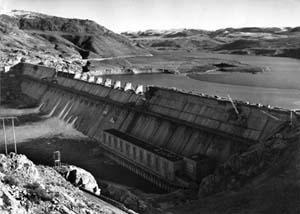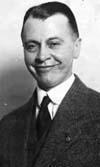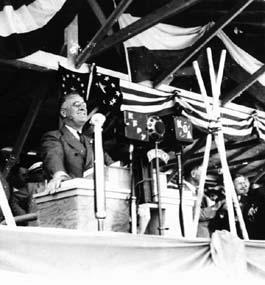By Sharon Boswell
and Lorraine McConaghy
Special to The Times

Construction of Grand Coulee Dam, often dubbed "the eighth wonder of the world,"
provided a tremendous boost to the regional economy during the Depression years.
Begun in 1933, the dam was only a year away from completion when this
photograph was taken in 1941. Photo Credit: U.S. Bureau of Reclamation / Seattle Times

Frank Edwards, Seattle mayor recalled in 1931.
ROOSEVELT PROMISED A MEASURE OF HOPE, although some conservatives
feared experimentation in the midst of crisis. One ad for the Republican incumbent, President Herbert Hoover,
cautioned, "Don't change barrels going over Niagara -- especially if you've hit bottom and
still are alive and kicking."
Nevertheless, despite a long history of Republican dominance,
Washington joined the nation in the Democratic sweep of 1932. Hartley, the two-term
Republican governor, was ousted in the primary, and the November election brought
Democrats into almost every major state and local office. Roosevelt's own margin
of victory was huge -- nearly 150,000 more votes than Hoover in Washington alone.
The new President immediately introduced legislation designed
to put people back to work and jumpstart the economy. FERA, the Federal Emergency
Relief Administration, became one of Roosevelt's first "alphabet soup" agencies
to provide relief locally, giving direct aid to the needy as well as seed money
for work projects. But the Civilian Conservation Corps (CCC) and the Works
Progress Administration (WPA) had the broadest regional impact.
The WPA put up federal money to support far-ranging projects:
streetcar, sewer and low-income-housing expansion in downtown Seattle; post-office,
library, school and public-building construction in smaller communities; and transportation
statewide, with financial help for airports, highways and even the Mercer Island floating bridge.
 President Franklin Roosevelt spoke to a crowd of nearly 20,000
when he visited the Grand Coulee Dam site Aug. 4, 1934. Photo Credit: Seattle Times.
President Franklin Roosevelt spoke to a crowd of nearly 20,000
when he visited the Grand Coulee Dam site Aug. 4, 1934. Photo Credit: Seattle Times.
WPA WORKERS INCLUDED HISTORIANS COMPILING A STATE GUIDE, artists painting murals
and women of all races sewing clothes for the needy. Self-help also continued to be a focus.
The WPA, for example, funded a cannery in Kirkland so local housewives could
preserve garden produce and save money for their families.
Legions of unemployed young men, primarily from the East,
became part of Uncle Sam's forest army, as the CCC was dubbed. They cleared trails,
fought fires and built recreational structures all over Washington, from state parks
at Deception Pass to National Forest campgrounds in the Cascade Mountains.
Shovel-leaning, time-wasting federal workers became the butt of jokes
in other parts of the country, but not here.
Yet the workers themselves were not always satisfied, claiming wages were too
low to live on and program cutbacks jeopardized family well-being. Forming their own unions,
WPA laborers marched, picketed and held sit-down strikes in protest, but with few results.
In August 1934, President Roosevelt revisited the Northwest for the dedication of
what became the "granddaddy of all New Deal projects," Grand Coulee Dam.
The dam was to harness the Columbia River for power and irrigation.
Lasting until 1942, the massive construction project brought thousands of jobs and billions
of federal dollars to the region, but was merely emblematic of the New Deal's
impact on the region as a whole.
Despite its doubters, the New Deal created a lasting impression on both
the people and the landscape of the Northwest, providing a broad foundation for future growth.
Historians Sharon Boswell and Lorraine McConaghy teach at local universities and do research,
writing and oral history. Original newspaper graphics courtesy of the Seattle Public Library.